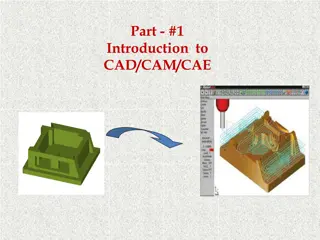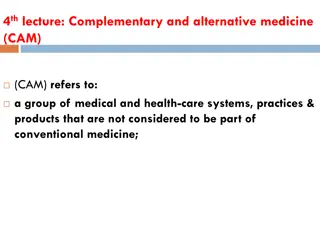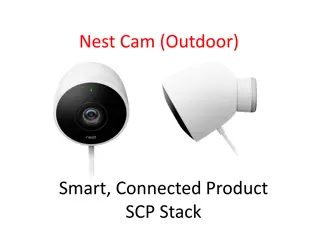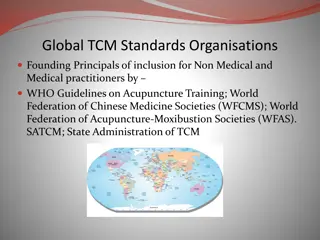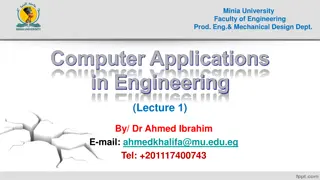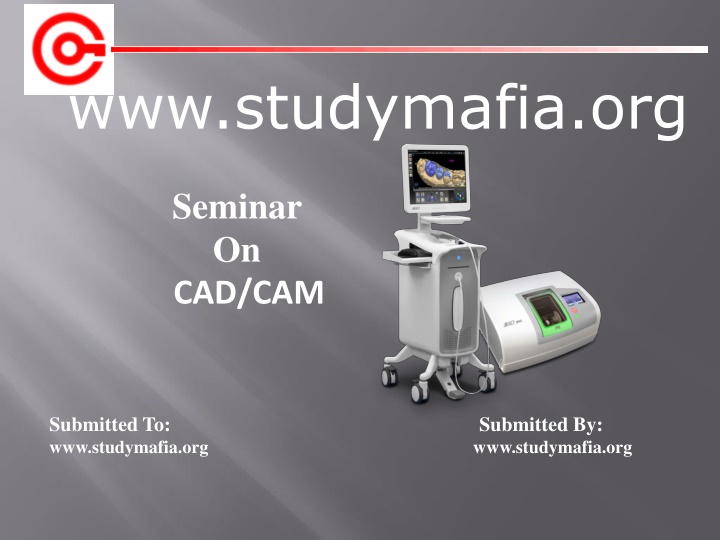
Exploring CAD/CAM Technology in Design and Manufacturing
Discover the impact of Computer-Aided Design (CAD) and Computer-Aided Manufacturing (CAM) technologies on the creation, development, and optimization of designs. Explore the benefits, limitations, and applications of CAD/CAM systems in modern industries. Learn how CAD/CAM play a crucial role in CIM technology and the future of engineering and design education.
Download Presentation

Please find below an Image/Link to download the presentation.
The content on the website is provided AS IS for your information and personal use only. It may not be sold, licensed, or shared on other websites without obtaining consent from the author. If you encounter any issues during the download, it is possible that the publisher has removed the file from their server.
You are allowed to download the files provided on this website for personal or commercial use, subject to the condition that they are used lawfully. All files are the property of their respective owners.
The content on the website is provided AS IS for your information and personal use only. It may not be sold, licensed, or shared on other websites without obtaining consent from the author.
E N D
Presentation Transcript
www.studymafia.org Seminar On CAD/CAM Submitted To: www.studymafia.org www.studymafia.org Submitted By:
Introduction What is CAD/ CAM Why CAD /CAM Use Types Interactive Computer Graphics Model of CAD/CAM Benefits Limitations Conclusion References
In this CIM technology CAD/CAM play an effective role. CAD/CAM system is ideally suited for designing and manufacturing mechanical components of free from complex 2-dimensional and 3-dimensional shapes. CAD/CAM technology plays an important role in functioning of robots. In CAD/CAM system the robot work data is prepared from CAD data from the first designing process.
Computer-aided design (CAD), Computer aided manufacturing (CAM) can be defined as the use of digital computer to assist the designer in the: Creation Development Modification Analysis Optimization of a design and manufacturing activity.
Computer Aided Design and Computer Aided Manufacture is the way things are made these days. Without this technology we wouldn t have the range and quality of products available or, at least, they wouldn t be available at a price most of us can afford. Hand-building and manual techniques still very much have their place and Design Education needs to treasure and foster these skills so that future generations will have the hands- on skills to understand the man-made world and provide the next generation of engineers, designers and technicians.
Computer-aided engineering (CAE) and Finite element analysis (FEA) Computer-aided manufacturing (CAM) including instructions to Computer Numerical Control (CNC) machines Photo realistic rendering Document management and revision control using Product Data Management (PDM).
3D wireframe is basically an extension of 2D drafting (not often used today). Each line has to be manually inserted into the drawing. 3D "dumb" solids are created in a way analogous to manipulations of real world objects (not often used today).
3D parametric solid modeling allows the operator to use what is referred to as "design intent". The objects and features created are modifiable. Explicit Modelers or Direct 3D CAD Modelers provide the ability to edit geometry without a history tree.
ICG is an important part of CAD system. It is a user oriented system using computer to create, transform and display data in the form of pictures or symbols.
Design and Design Analysis: CAD system would be best suited for drawing offices where frequent modification are required on drawing and several parts repeat. It must be remembered that it very easy with computer to make modifications and very fast to draw part profile once it details are feed in computer.
Introduction of computer has resulted in a better and consistent quality product at reduced costs . CAD has enable creation of assemblies and parts in the computer, there analysis, optimization, stimulating the functionality, aesthetic requirements etc. It has resulted lead time in the design office. Easy referencing and material of earlier design, data and information. Dependence on design subcontractors is reduced.
There are two primary limitations to CAD CAM restorations. (Like Cerec and E4D)It is not yet possible to do multiple unit bridges and the esthetics is limited. The esthetics has improved dramatically from the early days as the quality of materials has improved. Multi shade material blocks can duplicate dentin and enamel shades. Never the less, CAD CAM is not suited for highly esthetic situations.
Although the last seven years nothing revolutionary happened in the CAD tools ,the software's vendors support that in the short run many things will change the way of the mechanical design. The CAD in the future will be more easy to use and learn, and geared to enhance concept design and construction planning, will be functional and powerful enough to satisfy the needs of engineering design and integration of all disciplines, and corporate functions, sectors and levels.
www.studymfia.org www.google.com www.wikipedia.com




